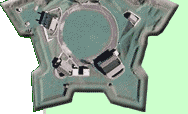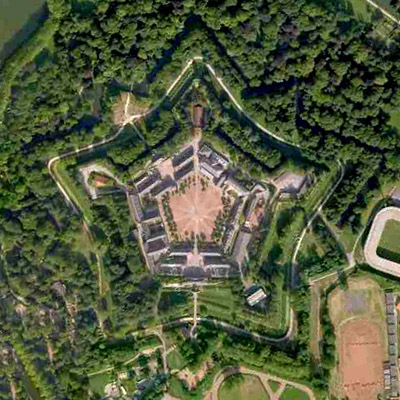
 |
 |
Citadelle de Lille Lille, France |
 |
 |
 |
 |
 |
||
 |
Lille, the fourth largest city in France, derived its name from "L'isle," as the original settlement was built on an island in a marsh. It is thought to have been founded in 640AD, and through the years it has been possessed by Gauls, Frisians, Saxons, Franks, Vikings, Normans, Magyars, the Spanish, and, eventually, French people. Through a head-spinning swirl of royal marriages through the Middle Ages and beyond, Lille wound up being occupied by Spain in the 17th century. When Spanish King Philip IV (1605-1655) died and Spain was busy collectively weeping in uncontrolled sorrow, France's King Louis XIV (1638-1715) swooped in and laid siege to Lille in 1667, making it part of France by 1668. Being part of France didn't necessarily please all of Lille's residents. As such, when cool cat Vauban arrived on the scene in 1670 to construct a starfort, he did so with as much of an eye towards the sullen malcontents of Lille's Saint Saveur quarter, whose residents "have nothing to lose and are, consequentially, the most seditious," as he did towards outside threats. Vauban did away with the city's medieval wall and constructed what he later called "the Queen of the Citadels" at Lille. Twas designed to be defended by 12,000 men, with 1,000 detailed to defend the citadel in the fort's center. The fort was completed in 1672. The Citadelle de Lille was put to the test in 1708, when the War of the Spanish Succession (1701-1714), fought by most of Europe's powers over the possible uniting of France and Spain under one king (which would upset the balance of power and we can't have that), brought the Dutch to Lille. The Dutch and their allies besieged the Citadelle de Lille for four months before its commander, Marshal Boufflers (1644-1711) surrendered, as his garrison had run out of gunpowder. The siege had cost the allies 15,000 casualties, many from the diseases that inevitably travelled with armies in those days. The Dutch hung around until 1713, when the Treaty of Utrecht was signed and the war concluded. Aside from a few paltry riots and the destruction of a church or two, Lille didn't participate in the French Revolution (1789-1799) to the extent that Paris did. Austria was kind enough to take up the slack, however, and in 1792 arrived at Lille to besiege the city. Austrian artillery destroyed lots of homes and the city's biggest church, but Lille did not surrender, and after waiting all of eight days the Austrians left. Most of the Citadelle's fortifications were taken down towards the end of the 19th century, leaving only the huge citadel and some of the outer walls, as well as widening the main gates to help the flow of traffic, which left the fort much as it looks today. It was just as well that there weren't 12,000 soldiers in the fort during the First World War (1914-1918), as the Germans shelled the snot out of Lille in the beginning of October 1914, and being in a star fort wouldn't have been much in the way of protection. The Germans occupied Lille after destroying great swaths of the city, but were driven out by the British on October 17 1918. Lille was also considered the hunting ground of German flying ace Max Immelmann (1890-1916), who no doubt enjoyed the view of the Citadelle from above. During the Second World War (1939-1945) the nazis took Lille in May of 1940. Having enjoyed the First World War as much as they did, many of Lille's residents had already fled the city when Belgium was invaded earlier in 1940. Lille was liberated by British, American, Canadian and Polish troops at the beginning of September 1944. Today the Citadelle de Lille is open for interested parties to poke around in. There is a museum in the Citadelle that includes breathtaking relief maps showing the fifteen fortified towns built in northern France, Holland and Belgium. |
 |
 |
||
|
|
|||||||
Info Source 1
Info Source 2
Info Source 3
Info Source 4 Info Source 5 Info Source 6 Info Source 7 Info Source 8 Info Source 9 Thanks to Google Maps for the image! ©2010 starforts.com |
 |